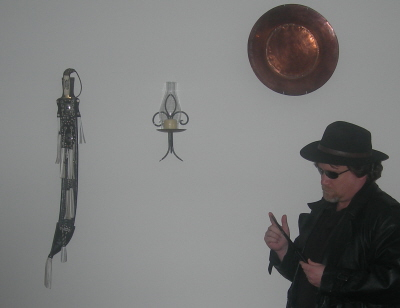|
About This Author
Come closer.
|
Complex Numbers
Complex Numbers
A complex number is expressed in the standard form a + bi, where a and b are real numbers and i is defined by i^2 = -1 (that is, i is the square root of -1). For example, 3 + 2i is a complex number.
The bi term is often referred to as an imaginary number (though this may be misleading, as it is no more "imaginary" than the symbolic abstractions we know as the "real" numbers). Thus, every complex number has a real part, a, and an imaginary part, bi.
Complex numbers are often represented on a graph known as the "complex plane," where the horizontal axis represents the infinity of real numbers, and the vertical axis represents the infinity of imaginary numbers. Thus, each complex number has a unique representation on the complex plane: some closer to real; others, more imaginary. If a = b, the number is equal parts real and imaginary.
Very simple transformations applied to numbers in the complex plane can lead to fractal structures of enormous intricacy and astonishing beauty.
| |
Nothing, save perhaps the Eiffel Tower and escargot, could be more quintessentially French than champagne, right? Or, as the French call it, "champagne."
Well, since you ask...
https://www.atlasobscura.com/articles/history-of-champagne
How an English Energy Crisis Helped Create Champagne
Desperate bottle-makers turning to a new fuel resulted in a sparkling innovation.
Turns out that, like gravity, crumpets, Doctor Who, and Russian Imperial Stout (no, really), champagne was a British innovation -- and the reason why will shock you! (Hey, look, I can write clickbait! Pay me!)
In the early 17th century, the kingdom of England was in the grip of the world’s first energy crisis. Decades of population growth, rapid urbanization, countless foreign wars, and myriad voyages of discovery to the New World under the capricious Tudors decimated the country’s forests and its timber supply.
They only lost 10% of their forests and timber supply? That doesn't sound so bad. Oh. No, the author is just misusing "decimate."
King James I was terrified.
Wasn't King James I Scottish? I can imagine a Scot being a lot of things, but "terrified" isn't one of them.
No trees for timber meant no ships for the navy, and no navy meant leaving the country wide open and undefended against England’s enemies—which, at this time, was pretty much all of the rest of Europe.
But, mostly, as per usual, France.
In particular, the proclamation explicitly forbade that anyone should be so wasteful as to “melt, make or causeth to be melted or made, any kind, form or fashion of Glass or Glasses whatsoever, with Timber, or wood, or any Fewell made of Timber of wood.”
It took me a bit to figure out what "Fewell" was. Fuel. Google was, for once, no help. But it's not like I spent a lot of time on it. Come on, I only give myself a half an hour to write these things. Maybe an hour, but that stretches my attention span to it- SQUIRREL!
But I think I get the idea. "Don't burn wood to make glass, or we'll send you to France."
The country’s glass-makers were outraged. They had been burning timber for centuries to make their product: an almost alchemical process of using fearsome heat to melt a mixture of potash and sand. What on earth were they to do now?
Harness the hot air coming from Parliament?
English wine has long been maligned.
And for good reason. But since French beer leaves quite a bit to be desired, I'd say they're even. Especially since they're both very skilled at making cheese.
And, in the 1600s, a new type of wine was being produced on the shores of England: refined and unique in character, to cater to the tastes of the affluent and upwardly mobile individuals who had flocked to the capital.
The article goes on to describe the basics of the process by which sparkling wine is crafted.
It is a method made famous, as the name suggests, by the French in the Champagne region. But here is the first known description of making “sparkling” wine—and Merrett writing that British vintners had been doing this for years.
The British are nothing if not creative. I mean, yeah, the French are, too, but again: gravity. And Russian Imperial Stout.
The problem with this new liquid, “brisk with spirits,” was that it generated an incredible amount of pressure. In a standard bottle of sparkling wine today, the internal pressure is at around six times that of atmospheric pressure—three times that of a car tire.
Which is the only fun part of drinking champagne: popping the cork and sending it flying across the room for the cats to chase.
Only an especially strong bottle could withstand this sort of pressure. Thankfully, England’s glass-makers were prepared.
And it's not just about the glass. The way the bottle is shaped is essential. Ever notice that sparkling wine bottles have a dimple in the bottom? That's like a three-dimensional version of an arch. Without it, the bottom would just pop right off.
After the royal proclamation a few years before, English glass-makers had reluctantly turned to coal. While wood was thought of as a noble fuel, across Europe coal was historically considered undesirable and dirty, and the act itself of mining it had been likened to vandalism or burglary from the earth ever since Roman times.
And it's beginning to be considered so again. Fortunately for everyone involved, we can generate massive heat without coal, these days.
Sure, coal gave off fumes and toxins, but it also reached a much higher temperature than timber, creating stronger, more durable, and thicker glass. Over time, artisans honed new industrial methods to take advantage of this discovery. While European counterparts were still using wood, the Champagne bottle as we know it was born in the furnaces of England.
And once again, we see that while necessity is the mother of invention (and laziness is the milkman), it's booze that drives the greatest innovations.
The founding myth of Dom Pérignon has played a vital part in transforming Champagne into one of the richest and most fiercely protected global food and drink regions. It is a convenient, if apocryphal, first-to-market story that has successfully given authority to the Champagne region over every other wine producing area. It was actually the infamous English sweet-tooth and the Londoner’s predilection for bubbles that first gave the wine-makers of Champagne inspiration; they just needed to work out how to create the right sort of bottle, like that of their cross-Channel cousins, in order to capitalize on the new potential market.
And we wonder why England and France were at war for nearly a thousand years, with stuff like this going on.
This, however, took some time. Replacing wood with coal in the bottle-making process was not adopted in France until after 1700, to imitate and reproduce bottles à la façon d’Angleterre (“in the English fashion”). But change was so gradual that, as late as 1784, French entrepreneurs were after the industrial “secret” of English bottle-making.
Basically, the article lays out a timeline and shows that the English invented the stronger bottle first.
It was not until the Industrial Revolution reached France that bottles could be produced with enough precision and standardization to withstand the pressure.
To be as fair as possible to France, their own contribution to the Industrial Revolution can't be ignored. Some of the earliest and most important work on steam engines was French.
Still, as with many origin stories, the French invention of champagne is une histoire fausse.
And I'll tell the story of Russian Imperial Stout one day. It's just too awesome not to share. But today is not that day. |
© Copyright 2025 Robert Waltz (UN: cathartes02 at Writing.Com). All rights reserved.
Robert Waltz has granted InkSpot.Com, its affiliates and its syndicates non-exclusive rights to display this work.
|

